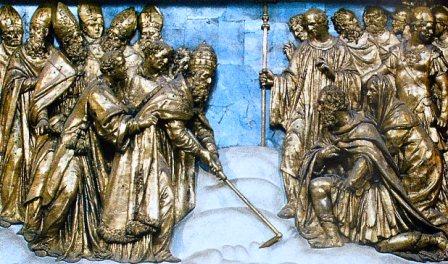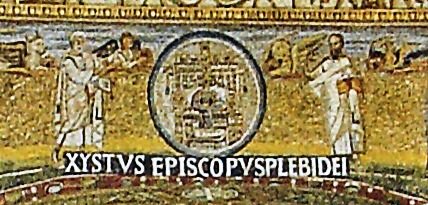 Pope Liberius (352-366) was Bishop of Rome in difficult times. In 350 Constans was assassinated and Constantius became the sole Emperor by defeating Magnentius. Some bishops in the East who opposed St. Athanasius in Egypt appealed to Liberius to get involved with the Arian controversy Athanasius was embroiled in.
Pope Liberius (352-366) was Bishop of Rome in difficult times. In 350 Constans was assassinated and Constantius became the sole Emperor by defeating Magnentius. Some bishops in the East who opposed St. Athanasius in Egypt appealed to Liberius to get involved with the Arian controversy Athanasius was embroiled in.
The Arian heresy and controversy was raging. (Arians didn’t want to acknowledge Christ as consubstantial with the Father: sound familiar?) Thus, Liberius called a for a Synod in Rome, but the Synod came to nothing. Liberius then made an appeal to Constantius to call a council to be held at Aquileia.
Constantius had Athanasius condemned by both the Synod of Arles (353) and the Synod of Milan (355) and tried to win Liberius over to his side. When Liberius resisted, Constantius summoned Liberius to Milan and then exiled him to Bearea in Thrace. Liberius eventually acquiesced to Constantius once he was weakened from his sufferings in hardship and the Thracian cold.
St. Hilary of  Poitier preserved letters of Pope Liberius attesting to what happened (Frag. Hist. 4,6).
Poitier preserved letters of Pope Liberius attesting to what happened (Frag. Hist. 4,6).
Eventually Constantius let Liberius come out of his exile in Thrace. He went to Sirmium in 358 and then back to Rome. In Rome Felix II had taken over as bishop, but the people backed Liberius as the true Bishop of Rome.
Liberius had more than likely subscribed to the formula of Sirmium of 351 which was a “fundamentally” orthodox statement. Some Eastern bishops and “moderate” Arians met in the presence of Constantius to oppose Photinus. Photinus was condemned. Liberius did not subscribe to Sirmium 357, however. This meeting issued a pro-Arian statement. Nevertheless, St. Athanasius and St. Hilary and others considered Liberius to have erred gravely, but they were probably mistaken. Granting that Liberius was weak and his pontificate was fraught with problems, partly of his own creation, Liberius seems to have been more sinned against than sinner.
Yes, Liberius did condemn Athanasius, that staunch defender of Nicaean faith against the heretic Arians. but he was forced under duress and perhaps even torture to give support to the Arians. Nevertheless, Liberius refused to subscribe to an obviously Arian formula of faith and instead signed on that, while not explicitly condemning Arianism, did support for the most part the Nicaean faith.
Sometimes anti-Catholics will fling Liberius in our faces as an example of how the Pope cannot be thought to teach infallibly. SSPXers often invoke him and Athanasius as a way of justifying their disobedience. Liberius, however, is a complex figure in difficult times and much of the “story” of his “fall” in weakness is not properly grasped.
After Constantius, the infamous Julian adopted a policy of toleration. Pope Liberius issued a letter to the bishops of Italy in 362 and a letter of reply to the bishops of the East in 366 which both affirmed the faith of the Council of Nicaea.
Pope Liberius is important to us today because of the feast we celebrate: the Dedication of St. Mary Major, known as the Liberian Basilica. The Basilica is associated with Pope Liberius because of the famous story we all know about the miraculous snowfall on this day on the Esquiline Hill in Rome. Anyone who has been in Rome in August will not question that at a snowfall would be indeed a miracle. To give you an idea of how hot it is in Rome in  August, the soles of a pair of my running shoes melted and the layers came apart. In any event, the Basilica was completed by Pope Sixtus III and his archdeacon Leo (later Pope Leo I “the Great”). Here is what the Roman Martyrology says:
August, the soles of a pair of my running shoes melted and the layers came apart. In any event, the Basilica was completed by Pope Sixtus III and his archdeacon Leo (later Pope Leo I “the Great”). Here is what the Roman Martyrology says:
Dedicatio basilicae Sanctae Mariae, Romae in Exquilis conditae, quam in memoriam Concilii Ephesini, in quo Maria Virgo Dei Genetrix salutata est, Xystus papa Tertius plebi Dei obtulit….
The dedication of the basilica of Saint Mary founded in Rome on the Esquiline hill, which Sixtus III, Pope consecrated for God’s People as a memorial of the Council of Ephesus during which the Virgin Mary was hailed as Mother of God.
In the basilica you can see the great triumphal arch decorated with beautiful mosaics prepared and directed by the future Pope Leo I having anti-Manichean themes. On the summit of the curve of the arch you see the name of “Xystus Episcopus Plebi Dei” even to this day.



















